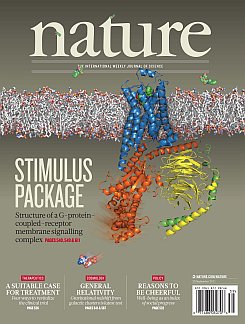 |
Figure: The β2 adrenergic receptor is shown in blue, the agonist is shown as green spheres, Gαs is shown in orange, Gβ is shown in yellow, and Gγ is shown in green. |
Recently, a collaborative research group headed by Brian Kobilka succeeded in obtaining the first high resolution structure of a GPCR-G protein complex: the β2 adrenergic receptor-Gs protein complex. GPCRs constitute a family of over 800 proteins with common structural and functional properties. GCPRs have seven transmembrane segments that transmit signals from an extracellular hormone or neurotransmitter agonist across the cell membrane to an intracellular signaling protein, a heterotrimeric guanine nucleotide binding protein (G protein). The agonist-GPCR-G protein complex is responsible for a majority of cellular responses to hormones and neurotransmitters. Consequently, GPCRs are one of the largest groups of targets for drug discovery. The β2 adrenergic receptor (β2AR) is a GPCR that responds to adrenaline and noradrenaline and activates Gs, the stimulatory G protein for adenylyl cyclase. The structure of the β2AR-Gs complex was solved with the help of the high-intensity mini-beam and rastering capabilities at the GM/CA beamlines. This structure provides the first high-resolution picture of transmembrane signaling by a GPCR.
Citation: Rasmussen SG, DeVree BT, Zou Y, Kruse AC, Chung KY, Kobilka TS, Thian FS, Chae PS, Pardon E, Calinski D, Mathiesen JM, Shah ST, Lyons JA, Caffrey M, Gellman SH, Steyaert J, Skiniotis G, Weis WI, Sunahara RK, Kobilka BK. Crystal structure of the β2 adrenergic receptor-Gs protein complex. Nature. 2011 Jul 19;477(7366):549-55. doi: 10.1038/nature10361.